Gestione delle vendite: Che cos'è? Come fare?
Tutto quello che dovete sapere per padroneggiare la gestione delle vendite
Siete pronti a trasformare le vendite da un'arte a una scienza?
La gestione delle vendite è la pratica di portare ordine in una professione intrinsecamente disordinata e profondamente umana: le vendite.
But why should we care? Can’t we just keep our sales jobs super spontaneous and fun?
Nobody said that you can’t keep sales fun while bringing good sales management to your company, but it certainly is a requirement if you want to scale your sales and your business.
In this guide we’ll quickly cover the following questions for you:
- Prima le basi: Cosa significa gestione delle vendite? In cosa consiste?
- Cosa deve fare un buon direttore vendite?
- Come si fa a gestire al meglio le vendite?
- Quali strumenti software possono aiutarvi?
- Quali libri e podcast fantastici potete consultare per continuare a saperne di più?
Nel caso in cui vogliate leggere solo un argomento specifico, potete cliccare sulla sezione appropriata qui sopra.
Ready to get the full briefing in under 10 minutes? Without further ado, let’s dive in. 👇
Definizione di gestione delle vendite: cos'è?
Sales management is the practice of creating a successful sales team by continuously building that team, setting out strategies for it, tracking its results, adjusting its processes and coaching its members to consistently hit your business’ sales targets.
Dividendo, questo significa che la gestione delle vendite copre generalmente tre aree:
- Gestione delle personeCostruire, allenare e fidelizzare il team di vendita.
- Leadershipsviluppare processi di vendita e strategie di vendita efficaci
- Vendite analisi dei datiTracciare, segnalare e regolare
If you effectively take control in these three areas, it will make sales more predictable for your business. No more accidental wins. You’ll have a solid and successful business.
Sounds good? Let’s explore what this means day to day and what concrete steps you can take.

Funzioni e responsabilità di un direttore vendite
Che cosa deve fare un sales manager ogni giorno per garantire il successo del suo team di vendita?
Well, here’s the different sales management responsibilities you need to pick up.
1. Reclutare, retribuire, mantenere e valutare un team di vendita
Le vendite sono interazione umana. E non si raggiunge la grandezza delle vendite senza un solido team di vendita.
Ciò significa che è necessario:
- Portare grandi giocatori nel team di vendita
- Motivare i clienti con il giusto compenso per le vendite.
- Manteneteli in squadra
- Valutare le loro prestazioni e adottare misure
2. Pianificazione e direzione
Anche un grande team non può funzionare se non si dà una strategia, un piano o una direzione.
Il vostro compito è quello di decidere su quali aree concentrarsi, come farlo, quando, ecc.
Questo include:
- Definizione degli obiettivi (più avanti)
- Definire le tattiche di lead generation (più avanti anche su questo)
- Assigning reps to different geographic areas, sectors, accounts, …
- Affinare il processo di vendita
- Qualsiasi altro aiuto richiesto dai vostri rappresentanti
Prendete in mano la situazione, fornite indicazioni e assicuratevi che tutti guardino nella stessa direzione.
3. Coaching dei rappresentanti di vendita
There’s higher level guidance, and then there’s coaching sales reps to improve their daily practice.
Depending on whether you do inside sales or field sales, this will mean you’ll have to listen into sales conversations on the phone (either live or recorded) or join them on the road to take part in meetings. Based on this you can help them with how to approach sales conversations and be more effective. This practice is called “shadowing”.
Può anche trattarsi di un coaching su come scrivere e-mail più efficaci, su come scrivere proposte migliori, su come negoziare accordi migliori, ecc.
4. Allineamento e collaborazione con altri dipartimenti
Your sales team is probably not alone in the company. And as you serve the customers, you need to interface with most of the other departments to do this better: marketing, finance, product, …
Your job is to represent your team as well as possible. For example, when your call centers receive inquiries and promise that a sales rep will follow through, it’s your responsibility to be ready to be of service. Alignment and proper workflow is important. Your job is to make sure that you work well together with the other teams and that information is exchanged as easily as possible, but also to give your team the necessary space and protection to do their job as well as possible.
5. Rapporti e analisi
Last but not least: you need to be on top of the numbers. Know exactly where you are versus targets, how well your team is performing, and where you can adjust or refocus to increase sales. Sales reporting is essential to optimizing your sales strategy or if it’s time to try something different.
This of course means you’ll need to have all the data to support this, which is exactly the first thing to implement when building a strong sales management system:
Sistema di gestione delle vendite: processi e strategie per ottenere quei numeri
Now that we know what sales management means and what your responsibilities as a sales manager are, let’s look at some processes and strategies you can implement to be successful at it.
1. Raccogliere tutti i dati necessari per essere organizzati e testare le strategie.
If you don’t know what’s happening, it’s very hard to properly take up most of your tasks. That’s why gathering data is one of the key steps you should take and there are plenty of tools, for example, scraper API that can help you with that.
Idealmente, si dovrebbero avere dati su:
- Quali sono le aziende con cui i vostri rappresentanti di vendita sono in contatto, qual è lo stato di avanzamento di ciascuna di esse e come procede ogni conversazione
- Quante opportunità avete nella pipeline di vendita, in quale fase, di quale valore, per quanto tempo, ecc.
- Quanto è attivo il vostro team di vendita e attraverso quali canali
- How many deals you’re winning and how many new opportunities you’re adding to your pipeline
- Da dove provengono i lead e perché le opportunità vengono generalmente perse
- Quali sono le aziende che vi portano più fatturato
- Quali opportunità stanno sfuggendo
Un buon CRM vendite può offrire queste informazioni nei suoi quadri.
If you’re using Salesflare, you have a Revenue dashboard:
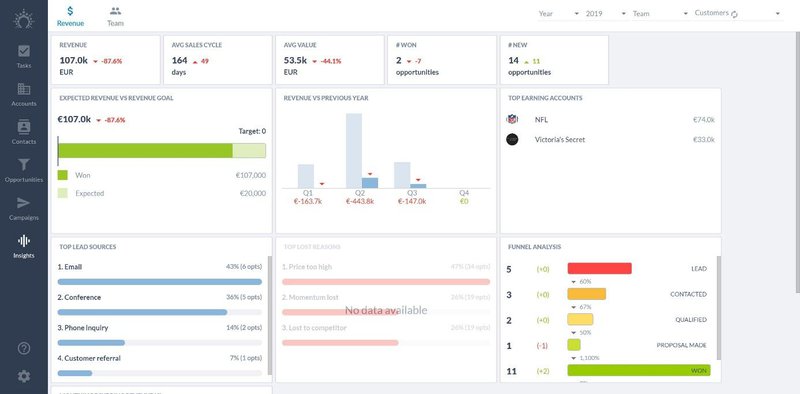
And there’s a Team dashboard:
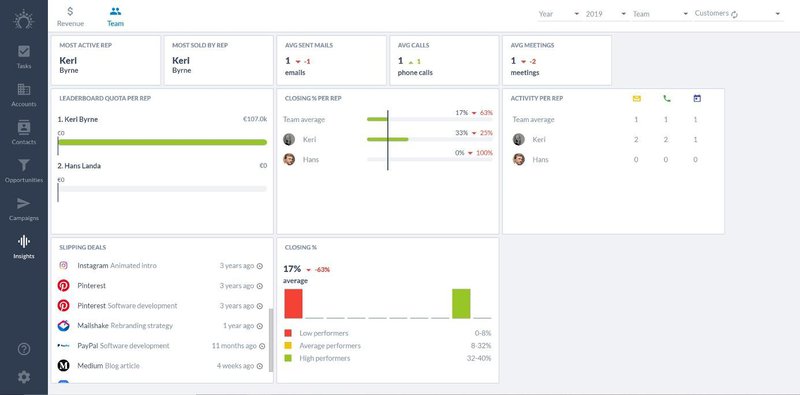
Naturalmente, prima è necessario raccogliere i dati e la maggior parte dei CRM richiede ai rappresentanti di vendita di inserirli manualmente. Questo richiede una grande quantità di tempo, energia e disciplina.
That’s actually why we created Salesflare: to automate that data input and easily provide you with all the data you need, without stressing out your sales team. But more on that on our website.
2. Fornire un feedback continuo al team di vendita
Data is no good if you keep staring at it and don’t put it to use.
Utilizzatelo per monitorare esattamente l'andamento del vostro team. Scoprite come possono migliorare. E poi, in ogni caso, parlatene con loro.
Creare forti cicli di feedback per mantenere i vostri rappresentanti di vendita aggiornati e in costante miglioramento. <Assicuratevi che sappiano come stanno andando e quali sono i punti principali su cui possono lavorare per avere più successo.
Don’t forget to put positive feedback loops in place as well. You can for instance hook up your CRM to Slack to communicate and celebrate wins. This can both bring a great atmosphere to your team and spur their competitive drive.
3. Garantire un buon afflusso di lead nella pipeline di vendita.
Without a good inflow of leads, your sales team’s performance can quickly drop to near zero.
If your sales reps are both responsible for creating new leads and for closing them, you’ll find that the team will naturally start working in cycles: first they have a lot of leads in the pipeline and they’re only working on closing them, then they run out of leads and start filling the pipeline again, after which the cycle restarts. This creates a lot of instability in the way your sales team functions.
To build a sales team that runs like a clock, it’s best to take responsibility over this area as the sales manager.
Either you work together with the marketing team to provide these leads, or – as one of the books in our below selection, Predictable Revenue, prescribes – you can divide the tasks of creating and closing leads in two different roles.
4. Assumere e mantenere un team eccellente
This one might seem obvious and we’ve touched upon it above, but we need to stress it again: building the best sales team is key.
It’s also more difficult than it might seem, because:
- Great sales people aren’t easy to find; and if you find them, they’re pretty good at selling themselves to other employers too.
- They’re also generally not that easy to retain, so you’ll need to go out of your way for this.
- If you make the wrong hiring decisions, you can’t keep up with bad hires forever. And firing people is notoriously hard to do.
- Even if you have the right people on board, they might lack motivation, direction, … or anything else that prevents them from being successful.
Vi consigliamo quindi di dedicare almeno un terzo del vostro tempo alla costruzione del vostro team e delle sue capacità.
5. Stabilire gli obiettivi, prevedere e monitorare
Molto più semplice da implementare e fondamentale per qualsiasi grande organizzazione di vendita: obiettivi da raggiungere.
La metrica più importante è un obiettivo di vendita annuale per rappresentante. In questo modo ogni rappresentante sa esattamente a cosa deve lavorare e quando viene considerato un successo.
Sia che si segua la filosofia di fissare obiettivi più bassi e raggiungibili per aumentare la fiducia dei rappresentanti (che si aumentano gradualmente), sia che si segua la filosofia di fissare grandi e audaci obiettivi per spingerli a nuove vette, è necessario fissare l'asticella.
After you’ve defined the targets, set them in your CRM and track them in dashboards that are internally visible to everyone in the sales team, so they can all clearly see where they’re at.
Dovrebbe essere visualizzato a livello individuale:
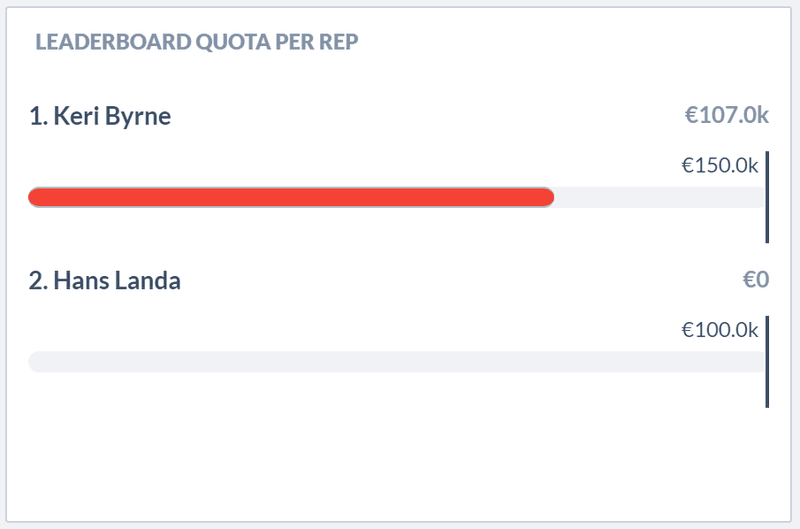
E anche a livello di squadra (con tutti gli obiettivi sommati per un obiettivo di squadra):
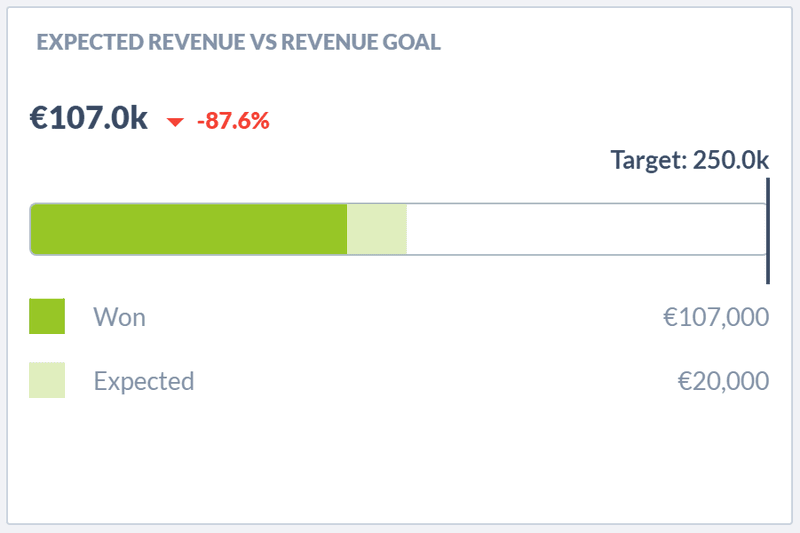
Per controllare i progressi verso questi obiettivi, un buon responsabile delle vendite di solito pianifica incontri settimanali o bisettimanali con i suoi singoli rappresentanti per analizzare le loro pipeline di opportunità. In questo momento, si può decidere insieme al rappresentante su quali affari concentrarsi e quali passi successivi compiere.
Tale pipeline di vendita sarebbe tipicamente visualizzata come un pannello Kanban trascinabile nel vostro CRM.
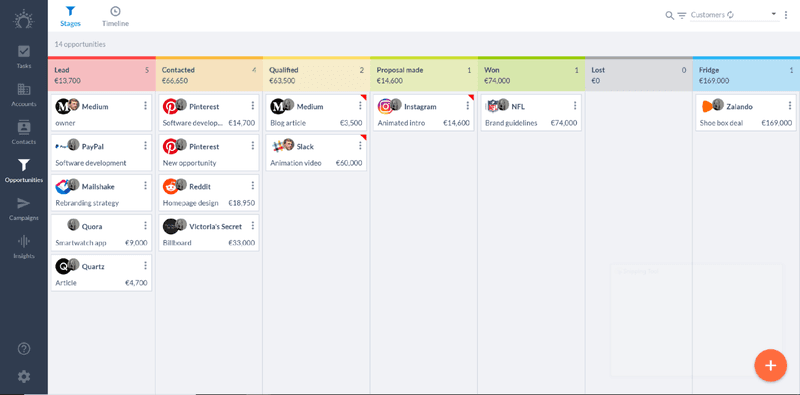
Strumenti software per la gestione delle vendite: CRM e non solo
Sebbene i dati siano fondamentali per molte responsabilità di un venditore, al giorno d'oggi, fortunatamente, molti nuovi software di gestione delle vendite si sono diffusi per aiutare i responsabili delle vendite a tracciare i dati di vendita in modo migliore e più semplice.
Central to all this is the CRM, but it’s definitely not all there is to help you.
1. Scegliere un CRM vendite
Sebbene esistano molte categorie di CRM, un CRM dedicato alle vendite vi semplificherà la vita.
Un buon CRM per le vendite fornisce ai rappresentanti uno strumento pratico per organizzare le vendite (mentre un CRM aziendale è più incentrato sulla fornitura di valore al management), il che significa che saranno più propensi a usarlo e che voi avrete i dati di cui avete bisogno.
Per scegliere quello giusto, vi suggeriamo di basarvi su questi criteri:
- Esperienza dell'utente: Again, if your sales reps don’t use the CRM, you can as well not have one.
- Accessibilità mobile: If you want them to really use the CRM, you can’t keep them chained to a computer.
- Capacità di automazione: L'automazione può aumentare la produttività delle vendite, ma anche fornire più dati con meno lavoro.
- Prezzi: Quanto si paga per tutto questo valore?
- Supporto: Can you expect help when you’re in trouble?
To save you some time, we’ve compared the most popular CRM options for you here.
Spoiler: questi sono i criteri che riteniamo più importanti, quindi scoprirete oggettivamente che, quando si tratta di questi criteri, Salesflare batte tutti gli altri. Soprattutto quando si tratta di automatizzare l'inserimento dei dati per i rappresentanti di vendita, che alla fine si assicureranno di avere tutti i dati necessari.
2. Allenare i rappresentanti con il software di monitoraggio delle chiamate
To make the job of “shadowing” your sales people’s phone conversations more easily at scale, in recent years software companies have been founded like Refract.ai and Gong.io.
Il software registrerà e analizzerà le conversazioni di vendita e vi fornirà alcune utili informazioni, come ad esempio le azioni dei vostri top performer nelle conversazioni che li portano al successo. Inoltre, vi darà consigli su come i singoli rappresentanti possono migliorare le loro conversazioni.
Sebbene queste piattaforme siano decisamente costose, diventa interessante esaminarle non appena il vostro team arriva a circa 5 addetti alle vendite interne o oltre.
3. Diffondere e monitorare l'uso del materiale di vendita
If you have a big sales team and you don’t know:
- Se i vostri rappresentanti di vendita hanno con sé e utilizzano il materiale più recente
- Come utilizzano questo materiale con i clienti
Allora potreste dare un'occhiata a software di abilitazione alla vendita come Showpad o Clearslide.
Non solo vi aiuterà a risolvere questi problemi, ma ad esempio aiuterà anche i vostri rappresentanti a trovare il materiale giusto per il cliente giusto al momento giusto.
Again, this is also mostly meant for bigger companies. If you’re small and lean, you probably won’t need this and won’t want to put down the money.
4. Completare il tutto con molti altri strumenti di vendita
Esistono molti altri strumenti in grado di aumentare la produttività delle vendite.
That’s why we compiled a list of the top sales tools you can look at.
If you’re using Salesflare already or would be looking to use it as your CRM, check out some of our integrations with other tools here. You can connect Salesflare with 1500+ other tools using Zapier, Integromat or PieSync.
Libri sulla gestione delle vendite: le 5 migliori risorse (e un bonus)
We’re not leaving you without some of our personal recommendations for further learning material. Below are 5 of the best sales management books you can read, plus some amazing podcasts.
If you’re into sales books in general, check out our selection of the best sales books as well.
Gestione delle vendite. Semplificato: La verità diretta su come ottenere risultati eccezionali dal vostro team di vendita, di Mike Weinberg
Mike Weinberg believes that managing sales teams doesn’t have to be complicated. In this book he highlights what to do and what not to do to be a great sales manager. It’s an honest read full of practical tips and can be easily read in a few takes.
Sales Manager Survival Guide: Lessons From Sales’ Front Lines, by David Brock
If you’re looking for a slightly meatier book, endorsed by the author of the previous book, this book by David Brock might be what you’re looking for. It’s a full guide to front line sales management, that covers many of the points we’ve touched above in a lot more detail. If you’re looking for a sales manager handbook, grab this one.
Ricavi prevedibili, di Aaron Ross e Marylou Tyler
Aaron Ross, previously a guest on our Founder Coffee podcast, explains how to build a modern sales organization, just like the one he helped building out at Salesforce. His main premise: separate your sales team into different roles. But that’s not all he discusses in the book. If you’re looking to improve your team’s sales processes, we recommend you read Predictable Revenue.
Allenare i venditori a diventare campioni: Un manuale tattico per manager e dirigenti, di Keith Rosen
Want to improve your sales coaching skills? Keith Rosen’s book covers exactly that topic, with a lot of detail. It might not be the most exciting book to read, but it’s an absolute must read for sales managers (and maybe even managers in general).
Cracking the Sales Management Code: I segreti per misurare e gestire le prestazioni di vendita, di Jason Jordan e Michelle Vazzana.
Infine, questo libro è tutto dedicato alle metriche di vendita. Un libro molto dettagliato, che potrebbe diventare un po' ripetitivo verso la fine. Tuttavia, prendetelo, leggete la prima parte e iniziate a misurare e gestire le vostre prestazioni di vendita come mai prima d'ora.
Bonus: Prefer listening? Here’s some great podcasts.
Spending some time on the go? You probably are. So why don’t you listen to some podcasts and keep your brain moving.
We’ve listed all the best sales podcasts for you.

Speriamo che questo post vi sia piaciuto. Se vi è piaciuto, spargete la voce!
👉 Potete seguire @salesflare su Twitter, Facebook e LinkedIn.
if(window.strchfSettings === undefined) window.strchfSettings = {}; window.strchfSettings.stats = {url: “https://salesflare.storychief.io/sales-management?id=1563153716&type=2”,title: “Sales Management: What is it? How to nail it?”,id: “b4bf56dd-9b24-4318-a472-b8522fe85e05”}; (function(d, s, id) { var js, sjs = d.getElementsByTagName(s)[0]; if (d.getElementById(id)) {window.strchf.update(); return;} js = d.createElement(s); js.id = id; js.src = “https://d37oebn0w9ir6a.cloudfront.net/scripts/v0/strchf.js”; js.async = true; sjs.parentNode.insertBefore(js, sjs); }(document, ‘script’, ‘storychief-jssdk’))- 8 vantaggi del CRM + 6 sfide da superare prima - 18 aprile 2024
- 30+ Migliori strumenti di generazione di lead (per tipo) - 16 aprile 2024
- 7 migliori CRM per Google Workspace + caratteristiche di integrazione - 11 aprile 2024
